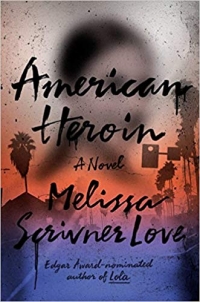American Heroin by Melissa Scrivner Love
 Wednesday, April 3, 2019 at 7:10AM
Wednesday, April 3, 2019 at 7:10AM 
Published by Crown on February 19, 2019
American Heroin is a sequel to Lola. You might want to read Lola because it’s a good book, and you should definitely read it before American Heroin to give context to some offhand comments that Lola Vazquez makes about her eventful past.
Lola is something of a criminal feminist, fighting to hold power as a gang leader in a profession that is dominated by men. To do that, she must be as tough and merciless as male gang leaders. Yet she brings a certain sensitivity to her work, an affinity for abused women and children, a conscience that does not let her live easily with the consequences of her violence.
Lola lives in Huntington Park in Los Angeles County, where she controls the heroin trade on certain street corners in partnership with a Machiavellian prosecutor named Andrea. Their partnership is uneasy, and Lola is not quite sure whether Andrea ever acts in anyone’s interest but her own. Lola, at least, takes care of her gang and her neighborhood, which she rules over like a benevolent but ruthless queen.
In the novel’s early stages, Lola is tricked into ordering the killing of man she doesn’t know. She also learns that a new cartel is taking the place of the one she helped bring down in Lola. Those two events turn out to be related in a way that puts Lola’s career and life at risk. What Lola does not immediately realize is that she has started a war that will also put her younger brother’s life at risk.
American Heroin introduces Louisa Mae, another victim of a violent childhood, a girl who learned in desperation to resort to violence herself. A cartel wants her dead because she is her father’s daughter. Louisa Mae’s story is interspersed with Lola’s. The reader eventually learns how those lives are connected. The connection is surprising.
Lola inhabits a world where, unlike white middle-class neighbors not far from hers, a child might catch a stray bullet at any moment. Lola’s adopted (sort of) daughter Lucy accepts the normalcy of that life, but Lola is adjusting to parental fears. The story’s best dramatic moments come not from Lola’s role as a gang leader, but from her insecurities as a mother. Multiple family dramas unfold as American Heroin steams to its conclusion.
Lola is a victim of her circumstances but she has learned to control those circumstances to the extent that control is possible. As Lola ponders the possibility of making a different kind of life, one in a safe neighborhood that isn’t associated with crime and violence, she wonders whether she would have a chance of being accepted in a white, upper-middle-class world, and whether she would want to be. A trip to Texas highlights the subtle racism that Latinas encounter in white-dominated environments.
Lola has more substance than a typical action hero, but when the time comes to fight, Lola can bring it. Like the last novel, this one includes a kick-in-the-gut moment that proves Lola’s ability to make tough decisions, substituting the ethics of a gang leader for the heart of a family leader. That Lola is a balance of good and evil may put off readers who always want to cheer for a protagonist, but I always prefer novels that recognize the war that so often rages in even the kindest hearts.
My most significant gripe about this series is that much of Lola’s substance is revealed through redundant monologues about what Lola is thinking or remembering. There are only so many times that Melissa Scrivner Love needs to tell the same story about Lola’s past or to share Lola’s present anxieties and doubts. There were times when I wanted to say “move on, we know this” except saying it would have been futile since Love wasn’t here to listen to my complaint. I also tend to be annoyed with novels that are written in the present tense (“Lola sets out to find Andrea”), but that might just be a personal quirk that won’t bother other readers.
As a thoughtful but fast-moving thriller with an unusual protagonist, American Heroin stands out from conventional crime novels. Lola might be an anti-hero, but she’s a hero to those who depend on her, just as Don Corleone was valued by those to whom he granted favors — until he came to collect a favor in return. I have enjoyed the character development in the two Lola books and I hope there are more on the horizon.
RECOMMENDED
